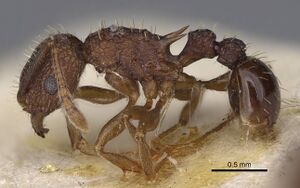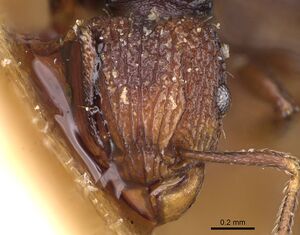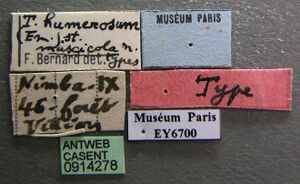Tetramorium angulinode
| Tetramorium angulinode | |
|---|---|

| |
| Scientific classification | |
| Kingdom: | Animalia |
| Phylum: | Arthropoda |
| Class: | Insecta |
| Order: | Hymenoptera |
| Family: | Formicidae |
| Subfamily: | Myrmicinae |
| Tribe: | Crematogastrini |
| Genus: | Tetramorium |
| Species: | T. angulinode |
| Binomial name | |
| Tetramorium angulinode Santschi, 1910 | |
| Synonyms | |
| |
A widespread but seemingly uncommon species usually inhabiting savannah or grassland, angulinode may also be found in forest clearings and in cultivated or otherwise disturbed ground within the forest zones. Nests of this species are usually made in the ground amongst the roots of grasses and low plants but it is also capable of nesting directly in the ground, especially at the bases of small trees. (Bolton 1980) In Benin, Taylor et al. (2018) report this species from mango (Mangifera indica) orchards, where it is prey of Oecophylla longinoda.
Identification
Bolton (1980) - Within the T. angulinode group the closest related species to angulinode are Tetramorium chloe and Tetramorium zapyrum, but in the first of these the postpetiole is strongly antero-posteriorly compressed and much narrower than the petiole in profile. In the second the dorsal surfaces of both pedicel segments are covered with a dense rugoreticulum, the spaces of which are packed with dense punctulate or granular sculpture so that both segments appear very rough and matt, not showing the open reticulum with shiny interspaces typical of T. angulinode.
Keys including this Species
- Key to Afrotropical Tetramorium species groups
- Key to Afrotropical Tetramorium angulinode species group
Distribution
Latitudinal Distribution Pattern
Latitudinal Range: 30.166667° to -20.16667°.
| North Temperate |
North Subtropical |
Tropical | South Subtropical |
South Temperate |
- Source: AntMaps
Distribution based on Regional Taxon Lists
Afrotropical Region: Benin, Botswana, Cameroun, Congo (type locality), Nigeria, Sudan, Zimbabwe.
Distribution based on AntMaps
Distribution based on AntWeb specimens
Check data from AntWeb
Countries Occupied
| Number of countries occupied by this species based on AntWiki Regional Taxon Lists. In general, fewer countries occupied indicates a narrower range, while more countries indicates a more widespread species. |

|
Estimated Abundance
| Relative abundance based on number of AntMaps records per species (this species within the purple bar). Fewer records (to the left) indicates a less abundant/encountered species while more records (to the right) indicates more abundant/encountered species. |

|
Biology
Castes
Worker
               
| |
| . | |
Queen
Images from AntWeb
    
| |
| Type of Tetramorium humerosum. Queen (alate/dealate). Specimen code casent0914276. Photographer Michele Esposito, uploaded by California Academy of Sciences. | Owned by MNHN, Paris, France. |
Nomenclature
The following information is derived from Barry Bolton's Online Catalogue of the Ants of the World.
- angulinode. Tetramorium (Xiphomyrmex) angulinode Santschi, 1910c: 385, fig. 12 (w.q.m.) CONGO. Combination in Xiphomyrmex: Santschi, 1920b: 16; in Tetramorium: Bolton, 1980: 237. Senior synonym of daphnis, humerosum, papyri: Bolton, 1980: 237; of nullispinum: Bolton, 1995b: 404.
- daphnis. Xiphomyrmex angulinode var. daphnis Santschi, 1920b: 16, fig. 3 (w.q.) ZIMBABWE. Junior synonym of angulinode: Bolton, 1980: 237.
- papyri. Xiphomyrmex papyri Weber, 1943c: 374, pl. 16, fig. 36 (q.) SUDAN. Junior synonym of angulinode: Bolton, 1980: 237.
- humerosum. Tetramorium humerosum Bernard, 1953b: 246, fig. 13 (w.q.) CAMEROUN. Junior synonym of angulinode: Bolton, 1980: 237.
- nullispinum. Tetramorium nullispinum Bolton, 1980: 241 (w.) NIGERIA. Junior synonym of angulinode: Bolton, 1995b: 412.
Unless otherwise noted the text for the remainder of this section is reported from the publication that includes the original description.
Description
Worker
Bolton (1980) - TL 2:3-2-9, HL 0:56-0:72, HW 0:50-0:72, CI 94-100, SL 0-34-0:50, SI 64-70, PW 0:42-0:56, AL 0-66-0-86 (15 measured).
Mandibles smooth and shining with scattered pits. Anterior clypeal margin with a small median impression. Antennal scrobes broad but shallow, their dorsal margins strongly defined by the frontal carinae, bounded weakly below by a longitudinal ruga running above the eye. A weak median longitudinal carina divides the anterior half of the scrobe into upper and lower sections, the carina running approximately to the level of the posterior margin of the eye. Pronotal corners square, distinctly angulate in dorsal view. Metanotal groove not impressed in profile but sometimes the alitrunk with a shallow step between the mesonotum and propodeum. Propodeal spines stout and acute, the metapleural lobes bluntly triangular. Petiole nodiform, in profile with the anterior and posterior faces vertical or nearly so, the dorsum feebly convex. Postpetiole in profile with the node about as long as that of the petiole, not anteroposteriorly compressed. In dorsal view the petiole node varying from slightly broader than long to slightly longer than broad; the postpetiole always much broader than long and considerably broader than the petiole. Head and alitrunk irregularly longitudinally rugulose, usually with very few cross-meshes except on the occiput where a narrow reticulum is present. Spaces between the rugulae shining, with weak ground-sculpture only. Dorsal surfaces of petiole and postpetiole with an open reticulum, the meshes of which are often broken or effaced in patches on one or both of the segments, leaving shiny unsculptured areas. Petiole with a fine narrow ridge running transversely across the junction of the anterior and dorsal faces and continuing obliquely down the side of the node towards the posteroventral corner. Side of petiole above this ridge more strongly sculptured than below it. First gastral tergite often with a band of widely scattered coarse punctures basally but this is reduced or absent in many specimens. All dorsal surfaces of head and body with numerous short, fine hairs, those on the gaster suberect to subdecumbent and, on the posterior two-thirds of the first tergite, directed towards the midline. Colour brown, varying from medium to dark.
References
- Bolton, B. 1980. The ant tribe Tetramoriini (Hymenoptera: Formicidae). The genus Tetramorium Mayr in the Ethiopian zoogeographical region. Bulletin of the British Museum (Natural History) Entomology. 40(3):193-384.
- Mbenoun Masse, P.S., Ebolo, G.L.M., Titti, G.E., Mony, R. 2021. Ant species richness, abundance and functional groups along an elevation gradient in Central Cameroon. Biodiversity Journal 12(1): 179-194 (doi:10.31396/biodiv.jour.2021.12.1.179.194).
- Santschi, F. 1910c [1909]. Formicides nouveaux ou peu connus du Congo français. Ann. Soc. Entomol. Fr. 78: 349-400 (page 385, fig. 12 worker, queen, male described)
- Santschi, F. 1920b. Formicides nouveaux du Gabon, du Congo, de la Rhodesia et du Natal. Ann. Soc. Entomol. Belg. 60: 6-17 (page 16, Combination in Xiphomyrmex)
- Taylor, B., Agoinon, N., Sinzogan, A., Adandonon, A., Kouaguou, Y. N., Bello, S., Wargui, R., Anato, F., Ouagoussounon, I., Houngbo, H., Tchibozo, S., Todjihounde, R., Vayssieres, J.F. 2018. Records of ants (Hymenoptera: Formicidae) from the Republic of Benin, with particular reference to the mango farm ecosystem. Journal of Insect Biodiversity 8(1): 6-29 (doi:10.12976/jib/2018.08.1.2).
- Yamane, S., Hosoishi, S., Ito, F. 2022. Japanese Tetramorium queens: identification key and species diagnoses (Hymenoptera, Formicidae, Myrmicinae). ZooKeys 1084: 43–64 (doi:10.3897/zookeys.1084.69767).
References based on Global Ant Biodiversity Informatics
- Bernard F. 1953. La réserve naturelle intégrale du Mt Nimba. XI. Hyménoptères Formicidae. Mémoires de l'Institut Français d'Afrique Noire 19: 165-270.
- Bolton B. 1980. The ant tribe Tetramoriini (Hymenoptera: Formicidae). The genus Tetramorium Mayr in the Ethiopian zoogeographical region. Bulletin of the British Museum (Natural History). Entomology 40: 193-384.
- Diame L., B. Taylor, R. Blatrix, J. F. Vayssieres, J. Y. Rey, I. Grechi, and K. Diarra. 2017. A preliminary checklist of the ant (Hymenoptera, Formicidae) fauna of Senegal. Journal of Insect Biodiversity 5(15): 1-16.
- Dieng M. M., A. B. Ndiaye, C. T. Ba, and B. Taylor. 2016. Les fourmis (Hymenoptera, Formicidae) de l’enclos d’acclimatation de Katane de la reserve de faune du Ferlo nord (Senegal). Int. J. Biol. Chem. Sci. 10(4): 1626-1636.
- IZIKO South Africa Museum Collection
- Levieux J. 1972. Etude du peuplement en fourmis terricoles d'une savane preforestiere de Cote d'Ivoire. Revue d'Ecologie et de Biologie du Sol 10(3): 381-428.
- Lévieux J. 1972. Les fourmis de la savane de Lamto (Côte d'Ivoire): éléments de taxonomie. Bulletin de l'Institut Fondamental d'Afrique Noire. Série A. Sciences Naturelles 34: 611-654.
- Santschi F. 1910. Formicides nouveaux ou peu connus du Congo français. Annales de la Société Entomologique de France 78: 349-400.
- Santschi F. 1920. Formicides nouveaux du Gabon, du Congo, de la Rhodesia et du Natal. Annales de la Société Entomologique de Belgique 60: 6-17.
- Stephens S. S., P. B. Bosu, and M. R. Wager. 2016. Effect of overstory tree species diversity and composition on ground foraging ants (Hymenoptera: Formicidae) in timber plantations in Ghana. International Journal of Biodiversity Science, Ecosystem Services & management 12(1-2): 96-107.
- Taylor B., N. Agoinon, A. Sinzogan, A. Adandonon, Y. N'Da Kouagou, S. Bello, R. Wargui, F. Anato, I. Ouagoussounon, H. Houngbo, S. Tchibozo, R. Todjhounde, and J. F. Vayssieres. 2018. Records of ants (Hymenoptera: Formicidae) from the Republic of Benin, with particular reference to the mango farm ecosystem. Journal of Insect Biodiversity 8(1): 006–029.
- Weber N. A. 1943. The ants of the Imatong Mountains, Anglo-Egyptian Sudan. Bulletin of the Museum of Comparative Zoology 93: 263-389.
- Wheeler W. M. 1922. Ants of the American Museum Congo expedition. A contribution to the myrmecology of Africa. II. The ants collected by the American Museum Congo Expedition. Bulletin of the American Museum of Natural History 45: 39-269.
- Wheeler W. M. 1922. Ants of the American Museum Congo expedition. A contribution to the myrmecology of Africa. VIII. A synonymic list of the ants of the Ethiopian region. Bulletin of the American Museum of Natural History 45: 711-1004

